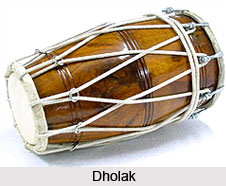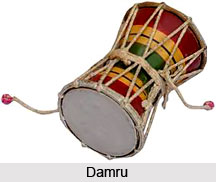The Happy go lucky attitude of the Kuchi have facilitated them to come up with various means for leisure activities. Some of them include drama, games, and story telling, as well as music. Them all these, music plays an integral parts of the entertainment process.
Bhorr & Bhorrinbo
In Kutch, it is known as Bhorrindo, while in other part of Sindh, it is also known as Borrindo or Borendo. Bhorrindo is known in the western world as Ochirina or Ocarina. It is very ancient folk instrument of music. Bhorrindo is a simple hollow clay ball or like an egg shaped with three to four holes, one somewhat larger than others. The holes are arranged in an isosceles triangular form. The Bhorrindo is made out of soft alluvial clay.
The sound notes are produced by blowing somewhat horizontally into the larger hole. Finger tips are placed on the smaller holes to regulate the notes. It is easy to play and hence its popularity among children and young who sound sweet notes on it while grazing the cattle.
Dak or Dakul
Dak or Dakul belongs to the Damru Family. The shape of the Dak or Dakul is similar to the shape of the Damru, but bigger in size sometimes. It is played to create a horrifying atmosphere.
The body of the Dacca or Dakar is made of an hour-glass frame with vellum drum heads. The heads are usually of calf skin, tied to hoops on both sides and braced and tightened with ropes. It is struck only one side either by hand or by stick. The cords are pressed and released in quick succession to give varying degrees to tension to the skinheads effecting changes in tonal sound. The Dak or Dakul is mainly used by the medicants and jugglers of the Bhuva community. These Bhuvas play the Dak or Dakul at the time of elimination of the elements like ghost etc. Dak is also played while Observing tantrik-cult.
 Dholak
DholakDholak is one of the most important folk instruments of membraphonic class. It is used for accompaniment for singing and dancing. As such it is accepted as a percussion instrument for varied kinds of music, from modern film music to simple folk songs and dan. The shell or the main body of the Dholak is hollowed out of a solid block of wood, over the two usually equal size open ends of the hollowed cylinder; parchment is stretched by tightening cords of braces, through leather hoops on both sides. To achieve tonal variation between the two heads, generally a past of flour and iron filing is fixed on the parchment of the left side to permanently lower the tension of the left side head. Moreover small circular metal rings, loop or wooden pieces are passed through the braces which can be pulled on either side, to increase or decrease the tension of the heads. The right head is kept in high pitch and the left head is kept in low pitch. It is struck on both sides by the hands, fingers, knuckles and part of the palm. A metal ring is sometime tapped on the shell of the instrument.
Duff
Duff is an important folk instrument of rim-variety. It is an outdoor instrument and is used mainly for accompaniment with folk dance. Duff consists of an open circular frame of wood which is covered with skin on one side. The diameter of the Duff varies from three inches to three feet. Duff can be played either with the hand or with sticks. The Duff is played on many festive occasions like Holi, Muharram procession etc.
 Damaru
DamaruThe origin of the Damru has been attributed to great antiquity and its significance in Indian mythology has been cemented upon by scholars. Damru is associated with Lord Shiva in Hindu mythology. It is said that Lord Shiva played Damru at the time of tandem-nritya. The Damru is also represented as an attribute of Shiva Natraja in ancient sculptures.
For more visit the link below:
https://www.indianetzone.com/20/musical_instrument_kutchi_people.htm
https://www.indianetzone.com/20/musical_instrument_kutchi_people.htm